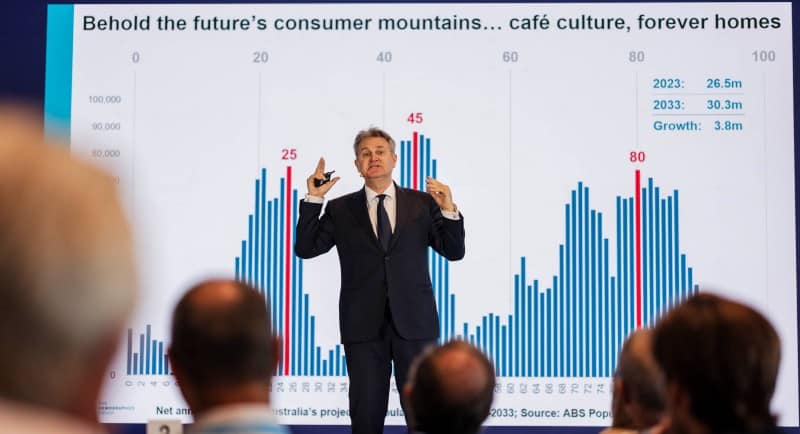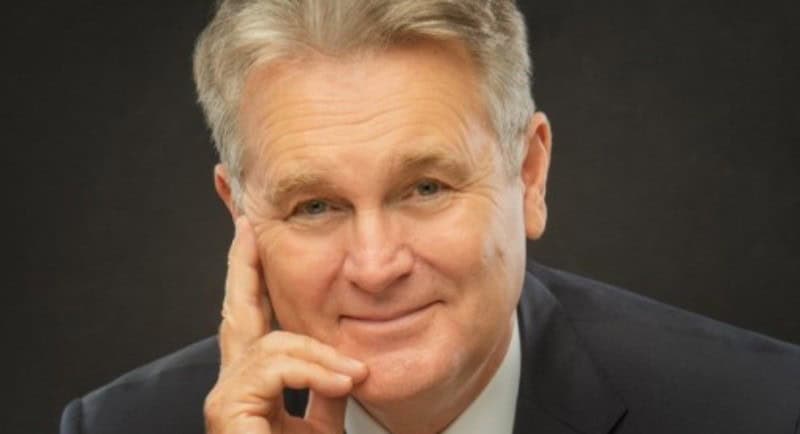“My observation of millennials is that they’re absolutely shameless,” Bernard Salt said.
“They had one view for the last 10-15 years, and now they all have another view, driven by pragmatism and need.”
During his keynote at AANA RESET, the renowned futurist, and proprietor of the viral “millennials can’t afford houses because of avocado toast” meme (although, Salt contended this was taken out of context), maintained that despite the prevalent cost of living concerns, Australia remains a wealthy country with strong population growth and export markets, predicting spend will only increase over the next decade.
See also: AANA RESET recap: LEGO, Matildas, Barbie, AB InBev
Speaking to Mediaweek after the keynote, Salt said that his argument is that despite feelings of “doom and gloom” in the current climate, “the reality is that we’re actually a very rich country, and there is every reason to be confident about the future, because of the scale of our export market relative to input.
“We’re selling overseas, we have strong population growth – with this, right or wrong is not the issue; the issue is that that does drive opportunity – and we’ve got a shift in the cohort structure of the population.”
In terms of the latter, Salt described the roughly 6 million millennials aged 25 to 39 who are transitioning from the single and coupled stage of the life cycle into the young parenting stage, exhibiting the aforementioned “shamelessness.”
“When you’ve got a baby, you can live in an apartment in St Kilda and Bondi, and keep it all minimalist and chic,” said Salt.
“The minute a toddler comes into play, your values shift. If you’ve got two kids under the age of four, you do need space. You do need a front garden or backyard, you do need three bedrooms, two bathrooms [and] a ‘zoom room.’”
Salt said he coined the term “zoom room” after casually hearing it from a real estate agent in October 2020, in response to COVID-19.
However, according to Salt, the current fixation marketers have on younger demographics is unsustainable, and the broad-brush assumptions applied to older demographics represents a significant opportunity cost.

“Growth has broadened. There are deepening pools of spending power that I think marketers need to identify and address. If I can encourage them to think broadly, and in a high altitude way to see the entirety of the market, rather than just go with what we’ve always done in the past… There are emerging markets elsewhere that I think can give a good return on investment that have been largely ignored, because people couldn’t see them.”
Namely, he believes that while the cornerstone of the young family remains important, “there are emerging markets elsewhere.”
He pointed to the growing pool of spending capacity in the over-55s demographic, many of whom will remain an active group with disposable income for decades to come. Salt said marketers need to adopt a more nuanced and robust approach to segmenting this older market.
“We need to broaden our horizons and offer detailed segmentation to the over 55s,” he said. “I think [marketers] need to be acknowledging them, and targeting them quite separately going forward.”
Looking at the last 50 years in Australian businesses, Salt explained how “it’s been all about the young.”
“But the reality is, there’s going to be a quantum of older people over the age of 55 in the next 10 years, and this means that you need to segment that market.”
Salt summarised existing segmentation as: ages 0-10 are “childhood”, 10-19 “teen”, 20-25 “young”, 25-40 is “partnering”, 40-55 is “peak income”, then “old.”
However, he argued that the latter should rather be characterised as 55-65, “downshift,” 65-79, “the great contentment,” 80-85 “old,” and over 85 as “frail elderly.”
In Salt’s view, these demographic milestones drive consumption behaviour. “They shift but they don’t bounce.”
“I’ve suggested 55 to 65 as being one market – they’re very active, probably still working, still consuming, kids off their hands, mortgage has been paid for. They’ve got a lot of disposable spending at that stage in the life cycle.
“Then 65 through to 79 or so is where grandchildren arrive… Then there is continued travel, wellness and wellbeing [and] maybe medical technologies.”
The simplest change Salt suggested marketers make is to start measuring, monitoring, and segmenting the market over the age of 55.
“There’s an immediacy now that was not there prior to the pandemic. I think that they’re ready and right to spend. They just need to be spoken to the right way and enticed into spending in various ways.”
Even in a post-COVID world, an extra 10% of the workforce (representing 1.4 million workers) are permanently, predominantly continuing to work from home. Salt said this is “one of the greatest shifts affected by the pandemic,” as it continues to impact home and technology purchasing decisions.
“I think there’s a remarkable commonality between Australians of today and Darryl Kerrigan of 1997,” he said, referencing the comedy classic, The Castle.
“In a way, we were still incredibly proud of our homes.
“If more people are working from home, they’re spending four days if not five days a week at home. Then spending on the home, you can rationalise, should be allocated a greater share of wallet, because it’s your work. It’s your rest and recuperation place. It’s your family space.”
He added that “the centre of gravity is shifting from arguably the inner city and the cafe to a [more suburban] ‘lifestyle zone.’”
Salt said that in past censuses, marketers didn’t pay much attention to the work-from-home force, given how minute its number – around 5%. They were forced to take notice around 2021 when the number surged to 21% due to the pandemic.
His prediction for the 2026 census is that “it’ll settle back to 15%.”
“If my prediction is right, Australia will never hear the end of it.”
See also: ‘There is no cutting corners’: Nic Taylor on LEGO’s craft, care, and fandom
–
Top Image: Bernard Salt
